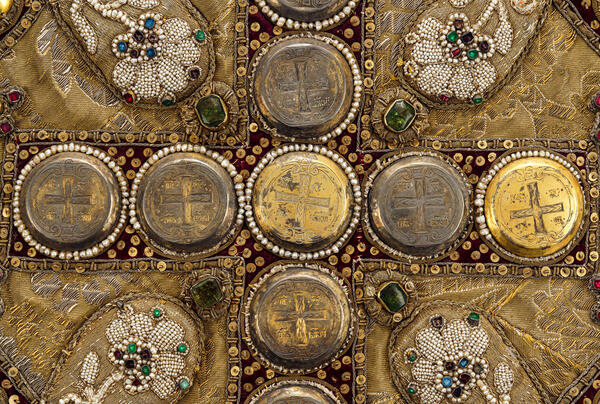The robes of the clergy denote their rank and position, thus distinguishing those ordained from lay people. This corresponds to the concept of the Church as the Kingdom Not of This World, and for the clergy it is a constant reminder that they must always, in any situation, be worthy of serving God.
Depending on the kind of service the clergy perform, they use a specific number of items of liturgical attire. Garments for evening and morning services, as well as for special services, except for the liturgy, include a stole (epitrachilion), cuffs (epimanikia) and a phelonion. The full set of vestments is used in the service of the Liturgy and in other cases as prescribed in the charter. The set includes a sticharion, with the orarion on top, as well as cuffs, a belt, and a phelonion. Some clergymen are awarded a nabedrennik (a square or rectangular cloth worn at the right hip) and a palitsa (epigonation). These items are not included in the mandatory set of liturgical garments.
A palitsa, or epigonation, is a part of the liturgical vestments of a bishop, archimandrite or priest. It is a rhomboid cloth that hangs on the right side of the body, suspended by its sharp corner on a ribbon. A palitsa is awarded for diligent service.
The palitsa, like the nabedrennik, symbolizes a spiritual sword. The diamond-shaped, four-sided palitsa represents the four canonical gospels, that is, the Word of God, with which the pastor should always be armed. But compared to the nabedrennik, the palitsa is a reward of a higher level, as it also symbolizes the edge of the towel with which Jesus Christ wiped the feet of His disciples.
The palitsa presented in the Museum of Russian Heritage is decorated with 13 large silver plaques that feature an image of a cross, the engraved inscription “Jesus Christ the Son of God” and 28 round smooth plaques.
In the center of the palitsa, nine large plaques
framed with small river pearls (partially lost) form a cross. Four large
plaques are placed at the corners. 28 round smooth plaques and sequins on
crimson velvet decorate the palitsa along the edges. There are tassels attached
to three corners of the palitsa. The surface of the brocade cloth is
embellished with large and small inserts of colored glass and pearls. The edge
of the palitsa is decorated with silver braid and a fine cannetille thread.





